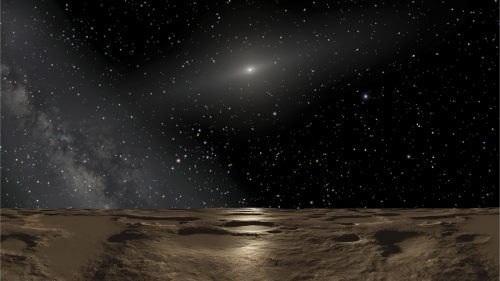The planet was discovered using software developed to locate moving bodies in astronomical photographs of distant galaxies taken at random intervals.

Scientists from the University of Michigan have discovered a new dwarf planet in our solar system. Its width is about 500 kilometers and its orbit is about 8.5 billion kilometers from the sun. It takes him 1,100 years to complete one lap around the sun.
But one of the interesting things about the new object, known as 2014 UZ224, is the way astronomers discovered it.
David Gardes of the University of Michigan led the team that discovered the new dwarf planet. Gerdes defines himself as a "mature astronomer" after starting his scientific career as a particle physicist.
He helped develop a special camera called the "Dark Energy Camera" that the US Department of Energy commissioned for the purpose of mapping distant galaxies. A few years ago Gerdes assigned a project to a number of students who came to work with him during a summer visit: he asked them to find objects in our solar system - on the galaxy maps.
The way to locate objects from the solar system in galaxy photos is to look for motion. The stars and galaxies are so far away, they are essentially stationary. But a planet or asteroid will change its position from night to night and will appear as a point of light that appears to move across the stationary background of stars. Connecting such points from photograph to photograph will also allow to start calculating the orbit of the object around the sun.
However, the photographs of the galaxies were not regular. "We often made one observation of an area in one night" he says. "And a few weeks later another observation and five nights later another observation, and four months later another observation. In this situation, connecting the dots is much more challenging, but they managed to develop software that can do just that.
The dwarf planet discovered by Gerdes and his colleagues joins a series of dwarf planets discovered in the last decade and a half, including Sadna, Eris and Maki-Maki, to which is added Pluto, which was demoted when the definition of objects in the solar system was changed and the category of dwarf planets was added. Gerdes does not rule out the possibility that it is essentially too small to be considered a dwarf planet, but for now it is defined as such.
As you recall, the dwarf planets are characteristic objects of the edge of the solar system, but as you recall, at the beginning of the year it was announced that At the edge of the solar system may be hidden a planet 10 times larger than Earth. At the beginning of this year, a scientific paper described the orbit of the ninth planet as it is called. Astronomers are constantly scanning the areas of the sky where that mysterious planet is likely to be found. Gerdes says it is possible that one of the photographs in his galaxy map survey may also contain this planet.
But of course, I would be happy for humanity even if someone else discovered it. It will be the most exciting astronomical discovery of our lifetime, in my opinion."
For more on the subject, visit the SKY AND TELESCOPE website
